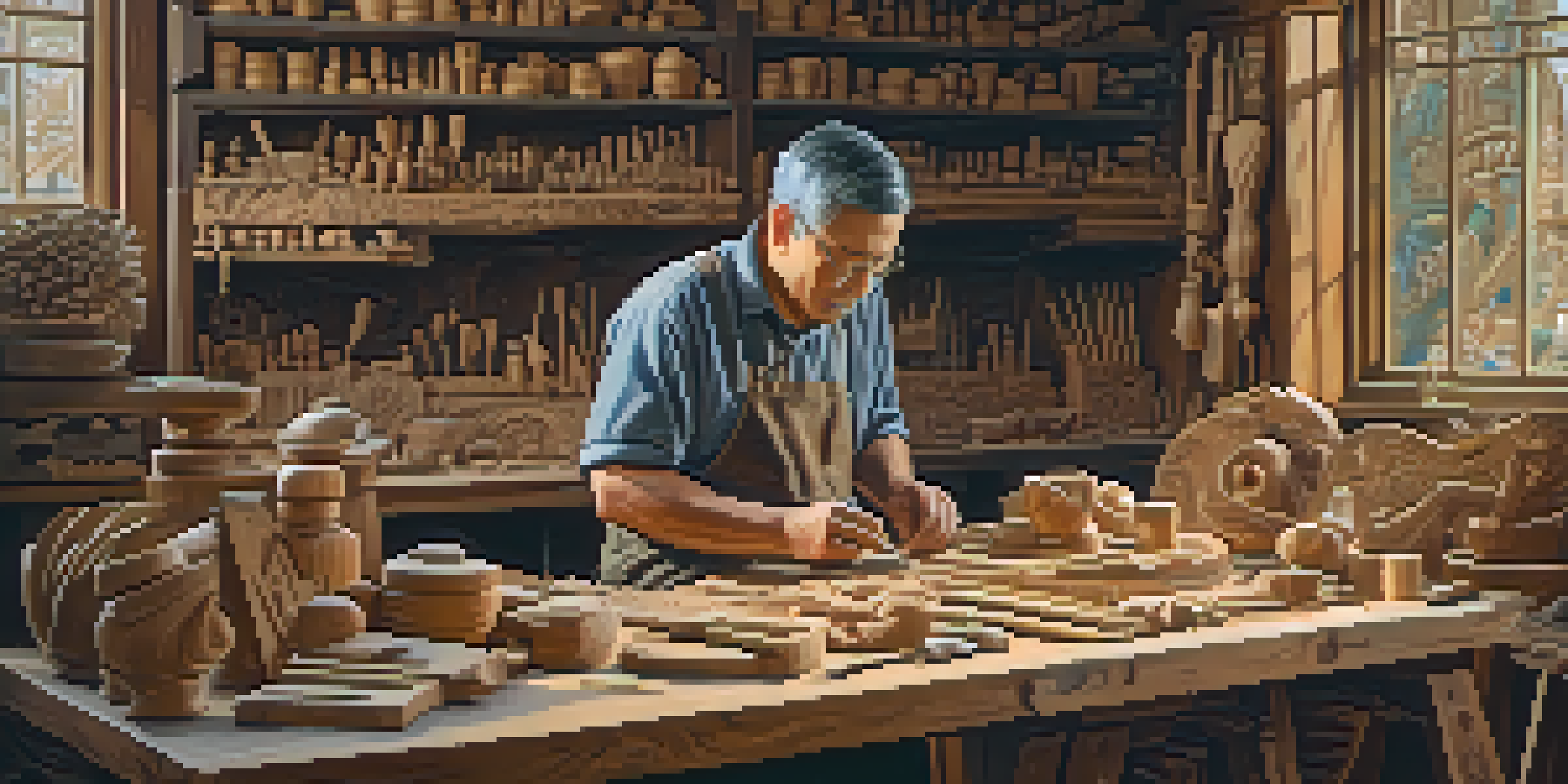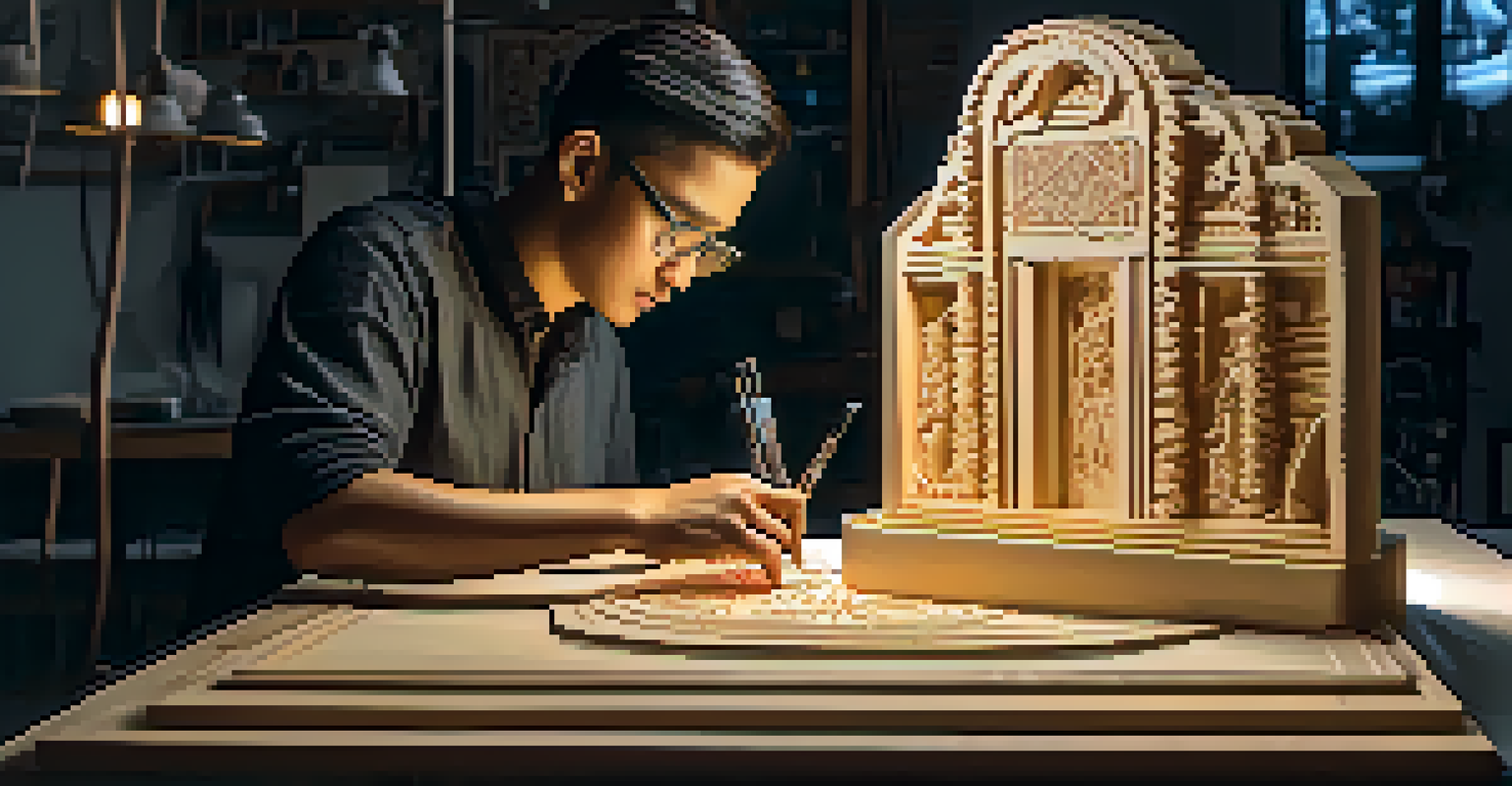Respecting Cultural Heritage in Contemporary Carving Practices

Understanding Cultural Heritage in Carving
Cultural heritage encompasses the traditions, practices, and artifacts that define a community's identity. In carving, this includes the techniques, styles, and stories passed down through generations. Respecting this heritage means acknowledging the importance of these practices in shaping how we understand ourselves and the world around us.
Tradition is not the worship of ashes, but the preservation of fire.
For example, indigenous carving styles often tell stories of creation, nature, and community values. When contemporary artists engage with these styles, they have a responsibility to honor their origins. This involves researching the cultural significance behind the techniques and symbols they wish to use, ensuring they are not merely decorative but are imbued with deeper meaning.
By understanding cultural heritage, carvers can create pieces that resonate with authenticity. This respect not only enriches their work but also fosters a deeper connection with the communities they draw inspiration from. Ultimately, it leads to a more profound appreciation of the art form itself.
The Role of Tradition in Modern Carving
Tradition plays a crucial role in contemporary carving practices, serving as a foundation for innovation. Many modern carvers draw inspiration from traditional methods, blending old techniques with new materials and technologies. This fusion can lead to exciting results, but it raises questions about authenticity and respect for the original practices.

For instance, a carver might use modern tools to replicate a traditional pattern. While the end result may be visually stunning, it's important for the artist to recognize and credit the cultural origins of that pattern. This acknowledgment not only honors the tradition but also educates the audience about the significance behind the work.
Cultural Heritage Shapes Carving
Understanding and respecting cultural heritage is essential for carvers to create authentic pieces that honor their origins.
Thus, while contemporary carving can push boundaries, it must also maintain a dialogue with its roots. This balance between innovation and tradition can enrich the artistic landscape, allowing for a diverse array of expressions that still respect the original cultural contexts.
Ethical Considerations in Carving Practices
As contemporary carvers explore cultural heritage, ethical considerations arise. Appropriating cultural symbols without understanding their significance can lead to disrespect and misrepresentation. It's essential for artists to approach this work with sensitivity and awareness, ensuring they are not exploiting cultural elements for personal gain.
Cultural heritage is the bridge to our past and the foundation for our future.
For example, using sacred symbols from a culture in a commercial piece can be seen as offensive. Artists must ask themselves whether their work contributes to the community's narrative or merely serves as a trend. Engaging with cultural representatives can provide valuable insights and prevent potential misunderstandings.
Ultimately, ethical carving practices foster respect and collaboration. By prioritizing dialogue and understanding, artists can create pieces that honor the cultural heritage they draw from, ensuring their work is not only beautiful but also meaningful.
Community Engagement in Carving Projects
Community engagement is a powerful way to respect cultural heritage in carving. Collaborating with local artisans and cultural leaders can provide invaluable insights and foster a sense of ownership over the work being created. This approach not only enriches the artistic process but also strengthens ties within the community.
For example, a carving project that involves local youth can educate them about their cultural heritage while allowing them to express their creativity. This hands-on experience can instill pride in their traditions and inspire a new generation of carvers. By involving the community, artists can ensure their work reflects authentic cultural expressions.
Balancing Tradition and Innovation
Contemporary carvers must blend traditional techniques with modern approaches while maintaining respect for the cultural significance behind their work.
Incorporating community voices into the carving process not only enhances the finished product but also builds lasting relationships. These collaborations can lead to a more profound understanding of the cultural elements being represented, ultimately creating art that resonates with both the artist and the community.
Preserving Techniques for Future Generations
Preserving traditional carving techniques is vital for maintaining cultural heritage. As modern tools and styles evolve, there's a risk that unique techniques may be lost over time. By documenting and teaching these methods, contemporary carvers can ensure that future generations have access to their cultural roots.
Workshops and educational programs can be effective ways to pass down these skills. Engaging younger audiences with hands-on learning experiences allows them to connect with their heritage. It's not just about teaching a skill; it's about instilling a sense of identity and belonging.
Furthermore, documentation can take many forms, from written guides to video tutorials. By creating accessible resources, artists can share their knowledge with a broader audience. This effort not only preserves techniques but also encourages appreciation for the rich tapestry of cultural heritage in carving.
The Impact of Globalization on Carving
Globalization has significantly influenced contemporary carving practices, bringing both opportunities and challenges. On one hand, it allows artists to share their work with a broader audience, promoting cross-cultural exchange. On the other hand, it can lead to the dilution of traditional practices as they are adapted to fit global trends.
For instance, a traditional carving style may be modified to appeal to international markets, potentially losing its original meaning. Artists must navigate this landscape carefully, balancing the desire for global recognition with the need to preserve their cultural integrity. This requires a thoughtful approach to how they present their work and the stories behind it.
Ethics in Carving Practices
Ethical considerations are crucial for artists to avoid misappropriation of cultural symbols, ensuring their work is meaningful and respectful.
Ultimately, globalization challenges artists to think critically about their role in the cultural narrative. By staying true to their roots while engaging with a global audience, contemporary carvers can create work that honors their heritage while still appealing to diverse tastes.
Innovative Approaches to Cultural Preservation
Innovation plays a crucial role in the preservation of cultural heritage within carving. As artists experiment with new materials and techniques, they can find fresh ways to tell traditional stories. This approach not only keeps the art form alive but also attracts new audiences who may not be familiar with the cultural significance behind the work.
For example, integrating digital technology into carving processes can open up new avenues for expression. Artists might use 3D printing to replicate intricate designs, allowing for greater accessibility without compromising the original techniques. This blend of old and new can create a dialogue that respects tradition while embracing modernity.

Moreover, innovative approaches can also include collaborations with other art forms, such as digital media or performance. These partnerships can highlight the cultural narratives behind the carvings, providing a richer context for the audience. By thinking outside the box, contemporary carvers can ensure that cultural heritage remains relevant and vital in today's world.